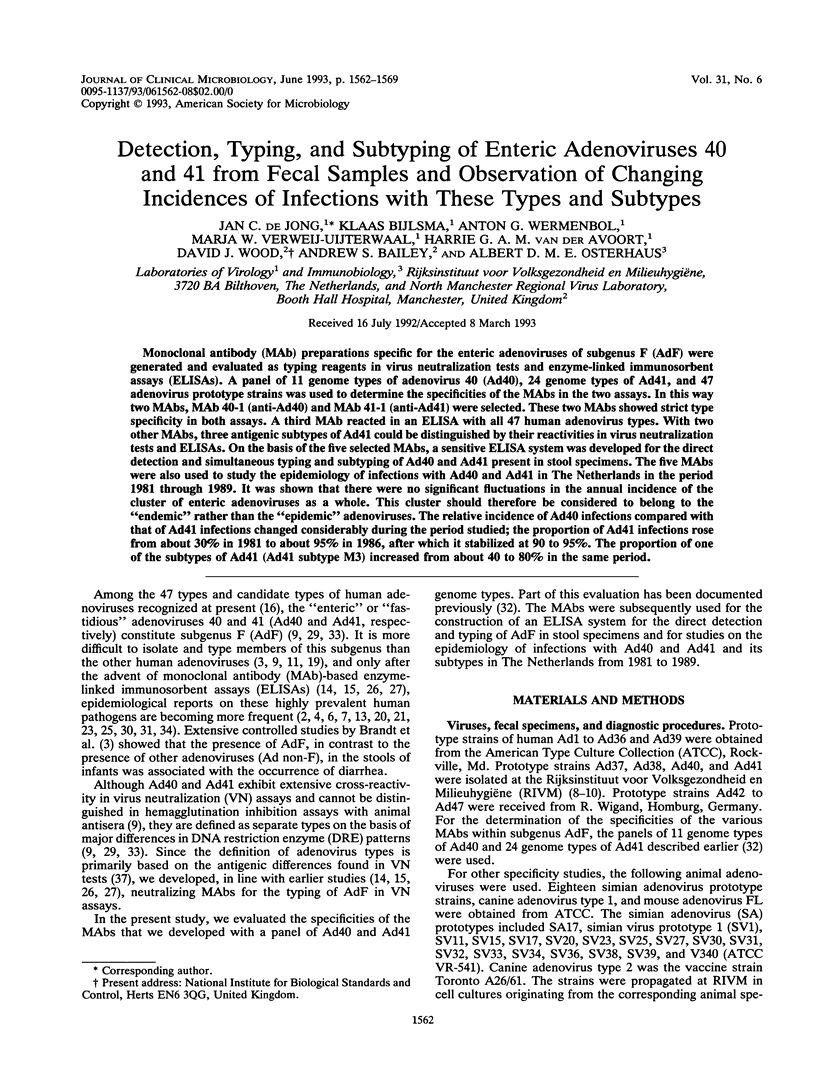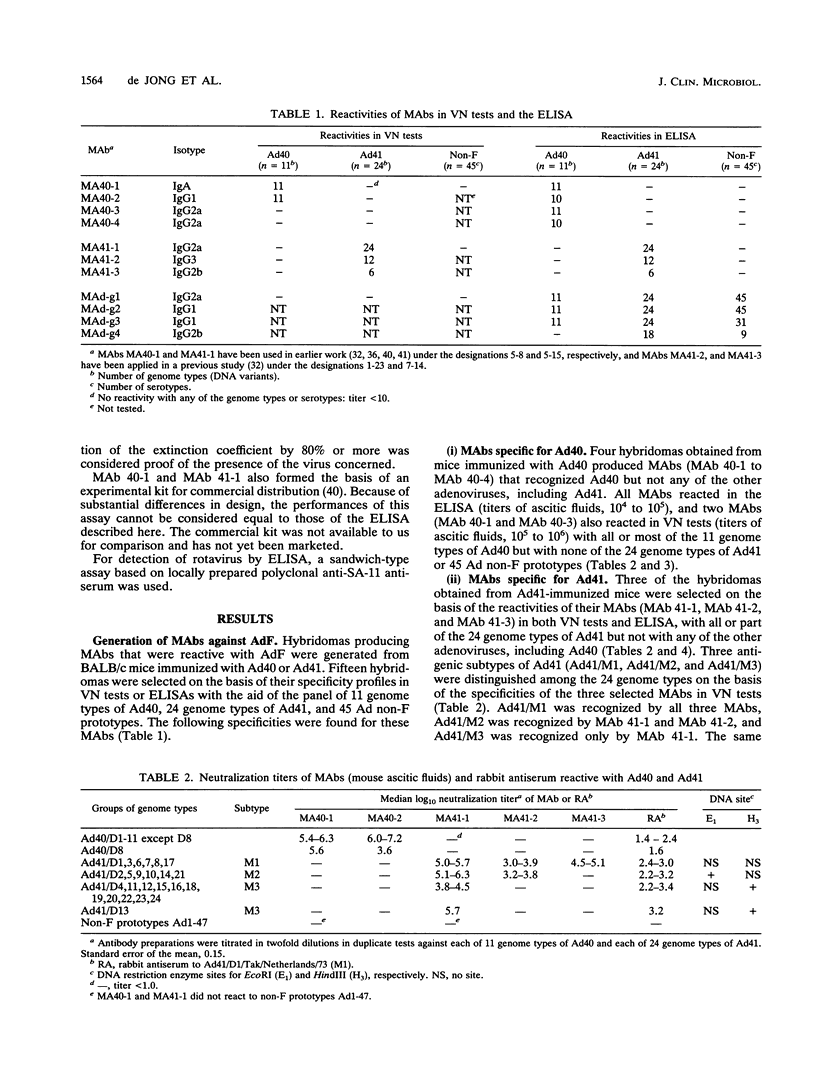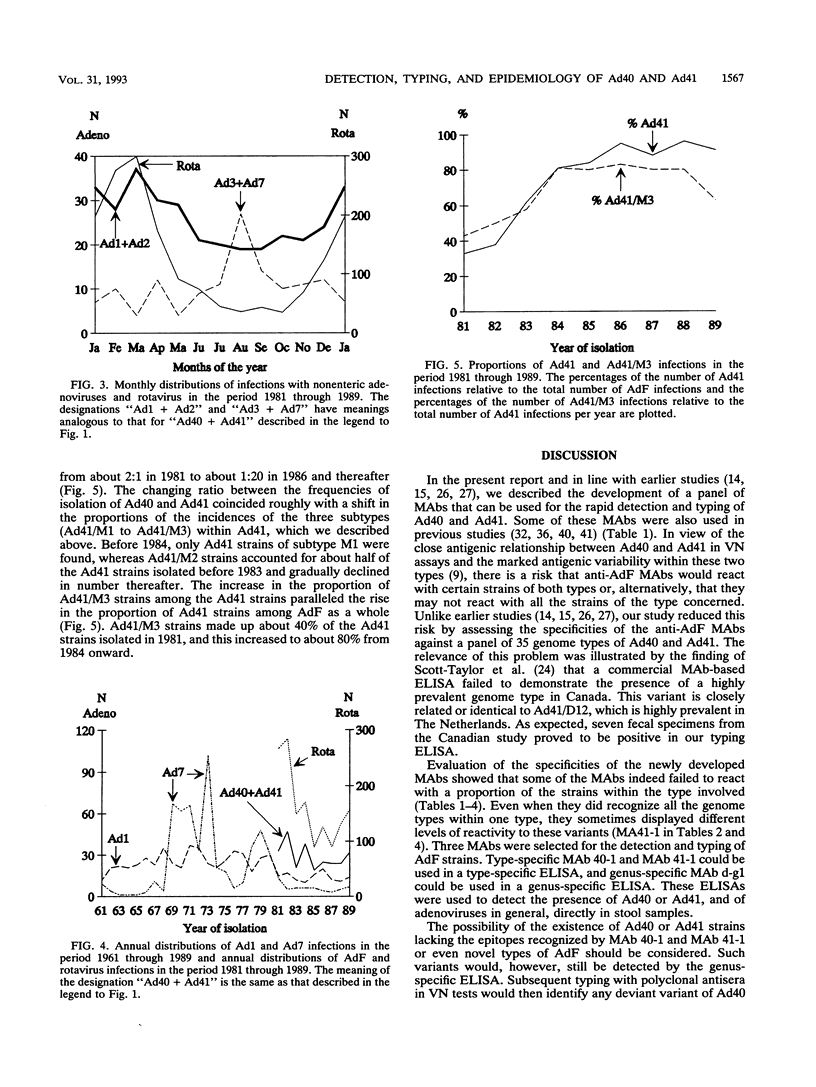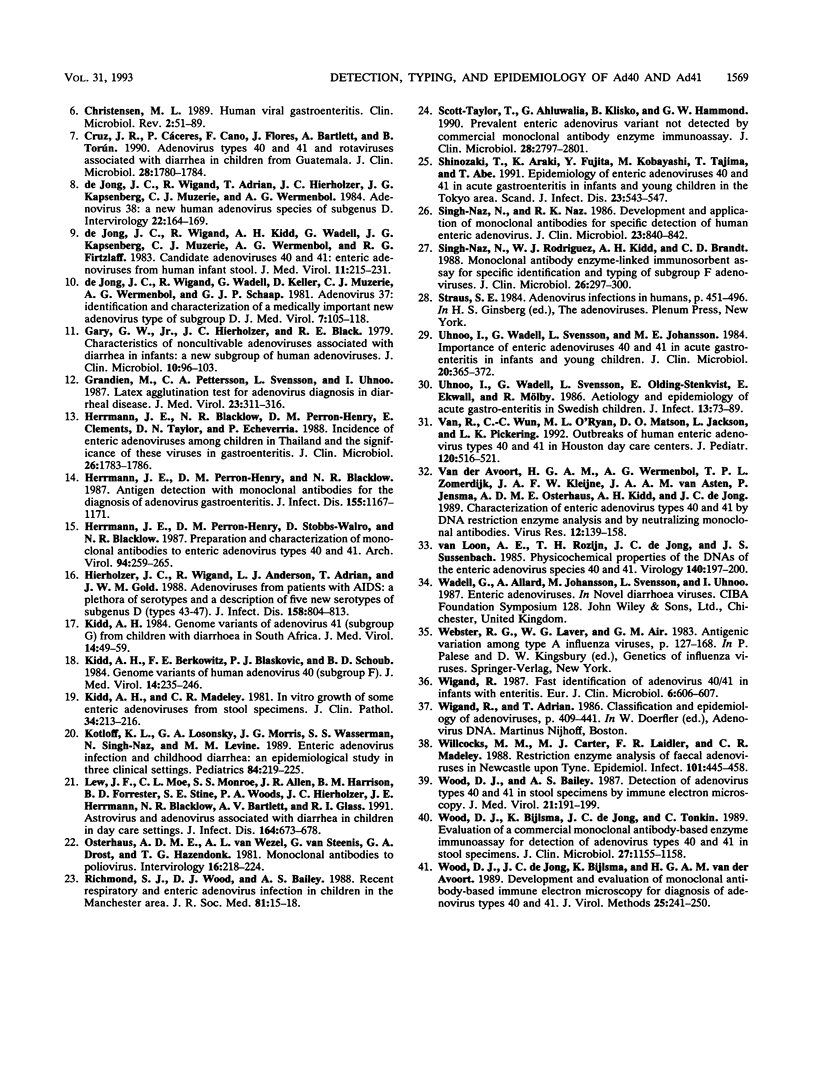Abstract
Monoclonal antibody (MAb) preparations specific for the enteric adenoviruses of subgenus F (AdF) were generated and evaluated as typing reagents in virus neutralization tests and enzyme-linked immunosorbent assays (ELISAs). A panel of 11 genome types of adenovirus 40 (Ad40), 24 genome types of Ad41, and 47 adenovirus prototype strains was used to determine the specificities of the MAbs in the two assays. In this way two MAbs, MAb 40-1 (anti-Ad40) and MAb 41-1 (anti-Ad41) were selected. These two MAbs showed strict type specificity in both assays. A third MAb reacted in an ELISA with all 47 human adenovirus types. With two other MAbs, three antigenic subtypes of Ad41 could be distinguished by their reactivities in virus neutralization tests and ELISAs. On the basis of the five selected MAbs, a sensitive ELISA system was developed for the direct detection and simultaneous typing and subtyping of Ad40 and Ad41 present in stool specimens. The five MAbs were also used to study the epidemiology of infections with Ad40 and Ad41 in The Netherlands in the period 1981 through 1989. It was shown that there were no significant fluctuations in the annual incidence of the cluster of enteric adenoviruses as a whole. This cluster should therefore be considered to belong to the "endemic" rather than the "epidemic" adenoviruses. The relative incidence of Ad40 infections compared with that of Ad41 infections changed considerably during the period studied; the proportion of Ad41 infections rose from about 30% in 1981 to about 95% in 1986, after which it stabilized at 90 to 95%. The proportion of one of the subtypes of Ad41 (Ad41 subtype M3) increased from about 40 to 80% in the same period.
Full text
PDF







Selected References
These references are in PubMed. This may not be the complete list of references from this article.
- Boursnell M. E., Mautner V. Recombination in adenovirus: crossover sites in intertypic recombinants are located in regions of homology. Virology. 1981 Jul 15;112(1):198–209. doi: 10.1016/0042-6822(81)90625-5. [DOI] [PubMed] [Google Scholar]
- Brandt C. D., Kim H. W., Rodriguez W. J., Arrobio J. O., Jeffries B. C., Stallings E. P., Lewis C., Miles A. J., Gardner M. K., Parrott R. H. Adenoviruses and pediatric gastroenteritis. J Infect Dis. 1985 Mar;151(3):437–443. doi: 10.1093/infdis/151.3.437. [DOI] [PubMed] [Google Scholar]
- Brandt C. D., Kim H. W., Yolken R. H., Kapikian A. Z., Arrobio J. O., Rodriguez W. J., Wyatt R. G., Chanock R. M., Parrott R. H. Comparative epidemiology of two rotavirus serotypes and other viral agents associated with pediatric gastroenteritis. Am J Epidemiol. 1979 Sep;110(3):243–254. doi: 10.1093/oxfordjournals.aje.a112809. [DOI] [PubMed] [Google Scholar]
- Brown M. Laboratory identification of adenoviruses associated with gastroenteritis in Canada from 1983 to 1986. J Clin Microbiol. 1990 Jul;28(7):1525–1529. doi: 10.1128/jcm.28.7.1525-1529.1990. [DOI] [PMC free article] [PubMed] [Google Scholar]
- Cepko C. L., Whetstone C. A., Sharp P. A. Adenovirus hexon monoclonal antibody that is group specific and potentially useful as a diagnostic reagent. J Clin Microbiol. 1983 Feb;17(2):360–364. doi: 10.1128/jcm.17.2.360-364.1983. [DOI] [PMC free article] [PubMed] [Google Scholar]
- Christensen M. L. Human viral gastroenteritis. Clin Microbiol Rev. 1989 Jan;2(1):51–89. doi: 10.1128/cmr.2.1.51. [DOI] [PMC free article] [PubMed] [Google Scholar]
- Cruz J. R., Cáceres P., Cano F., Flores J., Bartlett A., Torún B. Adenovirus types 40 and 41 and rotaviruses associated with diarrhea in children from Guatemala. J Clin Microbiol. 1990 Aug;28(8):1780–1784. doi: 10.1128/jcm.28.8.1780-1784.1990. [DOI] [PMC free article] [PubMed] [Google Scholar]
- Gary G. W., Jr, Hierholzer J. C., Black R. E. Characteristics of noncultivable adenoviruses associated with diarrhea in infants: a new subgroup of human adenoviruses. J Clin Microbiol. 1979 Jul;10(1):96–103. doi: 10.1128/jcm.10.1.96-103.1979. [DOI] [PMC free article] [PubMed] [Google Scholar]
- Grandien M., Pettersson C. A., Svensson L., Uhnoo I. Latex agglutination test for adenovirus diagnosis in diarrheal disease. J Med Virol. 1987 Dec;23(4):311–316. doi: 10.1002/jmv.1890230402. [DOI] [PubMed] [Google Scholar]
- Herrmann J. E., Blacklow N. R., Perron-Henry D. M., Clements E., Taylor D. N., Echeverria P. Incidence of enteric adenoviruses among children in Thailand and the significance of these viruses in gastroenteritis. J Clin Microbiol. 1988 Sep;26(9):1783–1786. doi: 10.1128/jcm.26.9.1783-1786.1988. [DOI] [PMC free article] [PubMed] [Google Scholar]
- Herrmann J. E., Perron-Henry D. M., Blacklow N. R. Antigen detection with monoclonal antibodies for the diagnosis of adenovirus gastroenteritis. J Infect Dis. 1987 Jun;155(6):1167–1171. doi: 10.1093/infdis/155.6.1167. [DOI] [PubMed] [Google Scholar]
- Herrmann J. E., Perron-Henry D. M., Stobbs-Walro D., Blacklow N. R. Preparation and characterization of monoclonal antibodies to enteric adenovirus types 40 and 41. Arch Virol. 1987;94(3-4):259–265. doi: 10.1007/BF01310718. [DOI] [PubMed] [Google Scholar]
- Hierholzer J. C., Wigand R., Anderson L. J., Adrian T., Gold J. W. Adenoviruses from patients with AIDS: a plethora of serotypes and a description of five new serotypes of subgenus D (types 43-47). J Infect Dis. 1988 Oct;158(4):804–813. doi: 10.1093/infdis/158.4.804. [DOI] [PubMed] [Google Scholar]
- Kidd A. H., Berkowitz F. E., Blaskovic P. J., Schoub B. D. Genome variants of human adenovirus 40 (subgroup F). J Med Virol. 1984;14(3):235–246. doi: 10.1002/jmv.1890140307. [DOI] [PubMed] [Google Scholar]
- Kidd A. H. Genome variants of adenovirus 41 (subgroup G) from children with diarrhoea in South Africa. J Med Virol. 1984;14(1):49–59. doi: 10.1002/jmv.1890140108. [DOI] [PubMed] [Google Scholar]
- Kidd A. H., Madeley C. R. In vitro growth of some fastidious adenoviruses from stool specimens. J Clin Pathol. 1981 Feb;34(2):213–216. doi: 10.1136/jcp.34.2.213. [DOI] [PMC free article] [PubMed] [Google Scholar]
- Kotloff K. L., Losonsky G. A., Morris J. G., Jr, Wasserman S. S., Singh-Naz N., Levine M. M. Enteric adenovirus infection and childhood diarrhea: an epidemiologic study in three clinical settings. Pediatrics. 1989 Aug;84(2):219–225. [PubMed] [Google Scholar]
- Lew J. F., Moe C. L., Monroe S. S., Allen J. R., Harrison B. M., Forrester B. D., Stine S. E., Woods P. A., Hierholzer J. C., Herrmann J. E. Astrovirus and adenovirus associated with diarrhea in children in day care settings. J Infect Dis. 1991 Oct;164(4):673–678. doi: 10.1093/infdis/164.4.673. [DOI] [PubMed] [Google Scholar]
- Osterhaus A. D., van Wezel A. L., van Steenis B., Drost G. A., Hazendonk T. G. Monoclonal antibodies to polioviruses. Production of specific monoclonal antibodies to the Sabin vaccine strains. Intervirology. 1981;16(4):218–224. doi: 10.1159/000149270. [DOI] [PubMed] [Google Scholar]
- Richmond S. J., Wood D. J., Bailey A. S. Recent respiratory and enteric adenovirus infection in children in the Manchester area. J R Soc Med. 1988 Jan;81(1):15–18. doi: 10.1177/014107688808100108. [DOI] [PMC free article] [PubMed] [Google Scholar]
- Scott-Taylor T., Ahluwalia G., Klisko B., Hammond G. W. Prevalent enteric adenovirus variant not detected by commercial monoclonal antibody enzyme immunoassay. J Clin Microbiol. 1990 Dec;28(12):2797–2801. doi: 10.1128/jcm.28.12.2797-2801.1990. [DOI] [PMC free article] [PubMed] [Google Scholar]
- Shinozaki T., Araki K., Fujita Y., Kobayashi M., Tajima T., Abe T. Epidemiology of enteric adenoviruses 40 and 41 in acute gastroenteritis in infants and young children in the Tokyo area. Scand J Infect Dis. 1991;23(5):543–547. doi: 10.3109/00365549109105175. [DOI] [PubMed] [Google Scholar]
- Singh-Naz N., Naz R. K. Development and application of monoclonal antibodies for specific detection of human enteric adenoviruses. J Clin Microbiol. 1986 May;23(5):840–842. doi: 10.1128/jcm.23.5.840-842.1986. [DOI] [PMC free article] [PubMed] [Google Scholar]
- Singh-Naz N., Rodriguez W. J., Kidd A. H., Brandt C. D. Monoclonal antibody enzyme-linked immunosorbent assay for specific identification and typing of subgroup F adenoviruses. J Clin Microbiol. 1988 Feb;26(2):297–300. doi: 10.1128/jcm.26.2.297-300.1988. [DOI] [PMC free article] [PubMed] [Google Scholar]
- Uhnoo I., Wadell G., Svensson L., Johansson M. E. Importance of enteric adenoviruses 40 and 41 in acute gastroenteritis in infants and young children. J Clin Microbiol. 1984 Sep;20(3):365–372. doi: 10.1128/jcm.20.3.365-372.1984. [DOI] [PMC free article] [PubMed] [Google Scholar]
- Uhnoo I., Wadell G., Svensson L., Olding-Stenkvist E., Ekwall E., Mölby R. Aetiology and epidemiology of acute gastro-enteritis in Swedish children. J Infect. 1986 Jul;13(1):73–89. doi: 10.1016/s0163-4453(86)92348-0. [DOI] [PubMed] [Google Scholar]
- Van R., Wun C. C., O'Ryan M. L., Matson D. O., Jackson L., Pickering L. K. Outbreaks of human enteric adenovirus types 40 and 41 in Houston day care centers. J Pediatr. 1992 Apr;120(4 Pt 1):516–521. doi: 10.1016/s0022-3476(05)82477-1. [DOI] [PubMed] [Google Scholar]
- Wigand R. Fast identification of adenovirus 40/41 in infants with enteritis. Eur J Clin Microbiol. 1987 Oct;6(5):606–607. doi: 10.1007/BF02014267. [DOI] [PubMed] [Google Scholar]
- Willcocks M. M., Carter M. J., Laidler F. R., Madeley C. R. Restriction enzyme analysis of faecal adenoviruses in Newcastle upon Tyne. Epidemiol Infect. 1988 Oct;101(2):445–458. doi: 10.1017/s0950268800054406. [DOI] [PMC free article] [PubMed] [Google Scholar]
- Wood D. J., Bailey A. S. Detection of adenovirus types 40 and 41 in stool specimens by immune electron microscopy. J Med Virol. 1987 Feb;21(2):191–199. doi: 10.1002/jmv.1890210211. [DOI] [PubMed] [Google Scholar]
- Wood D. J., Bijlsma K., de Jong J. C., Tonkin C. Evaluation of a commercial monoclonal antibody-based enzyme immunoassay for detection of adenovirus types 40 and 41 in stool specimens. J Clin Microbiol. 1989 Jun;27(6):1155–1158. doi: 10.1128/jcm.27.6.1155-1158.1989. [DOI] [PMC free article] [PubMed] [Google Scholar]
- Wood D. J., de Jong J. C., Bijlsma K., van der Avoort H. G. Development and evaluation of monoclonal antibody-based immune electron microscopy for diagnosis of adenovirus types 40 and 41. J Virol Methods. 1989 Sep;25(3):241–250. doi: 10.1016/0166-0934(89)90051-7. [DOI] [PubMed] [Google Scholar]
- de Jong J. C., Wigand R., Adrian T., Hierholzer J. C., Kapsenberg J. G., Muzerie C. J., Wermenbol A. G. Adenovirus 38: a new human adenovirus species of subgenus D. Intervirology. 1984;22(3):164–169. doi: 10.1159/000149546. [DOI] [PubMed] [Google Scholar]
- de Jong J. C., Wigand R., Kidd A. H., Wadell G., Kapsenberg J. G., Muzerie C. J., Wermenbol A. G., Firtzlaff R. G. Candidate adenoviruses 40 and 41: fastidious adenoviruses from human infant stool. J Med Virol. 1983;11(3):215–231. doi: 10.1002/jmv.1890110305. [DOI] [PubMed] [Google Scholar]
- de Jong J. C., Wigand R., Wadell G., Keller D., Muzerie C. J., Wermenbol A. G., Schaap G. J. Adenovirus 37: identification and characterization of a medically important new adenovirus type of subgroup D. J Med Virol. 1981;7(2):105–118. doi: 10.1002/jmv.1890070204. [DOI] [PubMed] [Google Scholar]
- van Loon A. E., Rozijn T. H., de Jong J. C., Sussenbach J. S. Physicochemical properties of the DNAs of the fastidious adenovirus species 40 and 41. Virology. 1985 Jan 15;140(1):197–200. doi: 10.1016/0042-6822(85)90461-1. [DOI] [PubMed] [Google Scholar]
- van der Avoort H. G., Wermenbol A. G., Zomerdijk T. P., Kleijne J. A., van Asten J. A., Jensma P., Osterhaus A. D., Kidd A. H., de Jong J. C. Characterization of fastidious adenovirus types 40 and 41 by DNA restriction enzyme analysis and by neutralizing monoclonal antibodies. Virus Res. 1989 Feb;12(2):139–157. doi: 10.1016/0168-1702(89)90060-9. [DOI] [PubMed] [Google Scholar]


